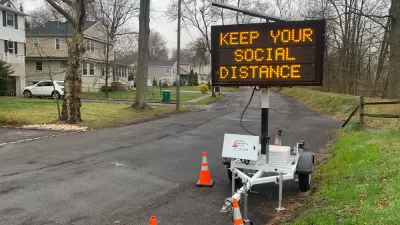"Prices will march on as they have," even if regulations relax to allow more housing supply in the market, according to a recent study by the Federal Reserve.

Erik Sherman shares a recent study from the Federal Reserve [pdf] that attempted to determine the amount of "elasticity" in the housing market—that is, how much new supply would be required to affect the price of housing. The study casts more than a little doubt on the notion that new supply will result in a commensurate lowering of prices (a position adopted by YIMBYs and policy makers in the Trump and Obama administrations alike)—in fact, the study argues that there is no evidence to support any determination about how much new supply it will take to lower the cost of housing.
"No one knows how much housing you'd have to add to have any significant impact on costs," explains Sherman of the ongoing question that launched the study. "So, the researchers built a simulation to estimate, directly from data, the elasticity of rent with respect to housing supply."
The key idea at the core of the findings is that elasticity isn't a simple phenomenon. "There are products where changing the price doesn't necessarily result in big shifts of demand. Look at the Apple iPhone X: $1,000 for the device and tens of millions purchased it."
The researchers also considered whether another approach could help lower prices, such as improving access to and the quality of public transportation in neighborhoods far from the city core. That solution likely only benefits those with larger incomes and more money to spend on housing. It creates a kind of "cascading gentrification engine," according to Sherman.
In the end, suggests Sherman, the only solution might be to reserve housing for lower-income people. "Hard to see that happening in the current political climate," however, concludes the article.
FULL STORY: Additional Building Won't Make City Housing More Affordable, Says Fed Study

Planetizen Federal Action Tracker
A weekly monitor of how Trump’s orders and actions are impacting planners and planning in America.

Congressman Proposes Bill to Rename DC Metro “Trump Train”
The Make Autorail Great Again Act would withhold federal funding to the system until the Washington Metropolitan Area Transit Authority (WMATA), rebrands as the Washington Metropolitan Authority for Greater Access (WMAGA).

The Simple Legislative Tool Transforming Vacant Downtowns
In California, Michigan and Georgia, an easy win is bringing dollars — and delight — back to city centers.

The States Losing Rural Delivery Rooms at an Alarming Pace
In some states, as few as 9% of rural hospitals still deliver babies. As a result, rising pre-term births, no adequate pre-term care and "harrowing" close calls are a growing reality.

The Small South Asian Republic Going all in on EVs
Thanks to one simple policy change less than five years ago, 65% of new cars in this Himalayan country are now electric.

DC Backpedals on Bike Lane Protection, Swaps Barriers for Paint
Citing aesthetic concerns, the city is removing the concrete barriers and flexposts that once separated Arizona Avenue cyclists from motor vehicles.
Urban Design for Planners 1: Software Tools
This six-course series explores essential urban design concepts using open source software and equips planners with the tools they need to participate fully in the urban design process.
Planning for Universal Design
Learn the tools for implementing Universal Design in planning regulations.
Smith Gee Studio
City of Charlotte
City of Camden Redevelopment Agency
City of Astoria
Transportation Research & Education Center (TREC) at Portland State University
US High Speed Rail Association
City of Camden Redevelopment Agency
Municipality of Princeton (NJ)





























